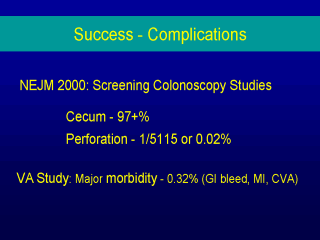 |
The first thing that you need to
understand about colonoscopy relative to sigmoidoscopy is that colonoscopy is a much
bigger production. You generally have to give people sedation for it, the preparation is
much more extensive, and the risk is greater because in maneuvering around more of the
colon you run greater risks of bad things. Looking at these studies, they really performed
very, very well. These were selected, first-rate endoscopists because as you can see they
had 97% reaching the end of the colon. They had only one perforation in 5,000 cases. We
tell patients you generally have a one in a thousand risk, one or two per thousand risk,
and you see they had a fraction of that. Major morbidity they estimated at .32%. Some of
these are not related to the colonoscopy per se but thatís what happens when you follow
a group of people for 30 days after procedure. Bleeding presumably was from the
colonoscopy. |
